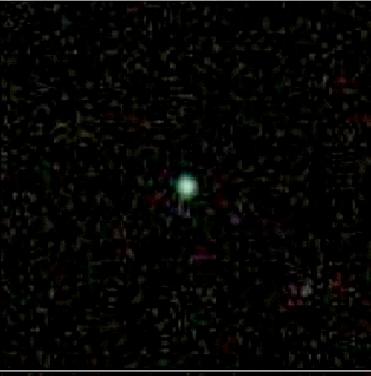
The Green Peas could be detected because of their small size and green colour. -- Image credit: Yale University
CONNECTICUT (BNS): In a discovery which could lend astronomers a unique insight into how galaxies formed stars in the early universe, a group of citizen scientists at the Yale University, US, has spotted a bunch of rare galaxies and named it as ‘Green Peas’.
The scientists, working voluntarily for an online project called Galaxy Zoo, came across an array of objects, small in size reflecting bright green colour. Hence, they named it Green Peas, the Yale University said in a statement.
After a detailed study, astronomers found that the small, compact galaxies have been forming stars at an incredibly high rate.
“These are among the most extremely active star-forming galaxies we’ve ever found,” said Carolin Cardamone, an astronomy graduate student at Yale and lead author of the paper, to be published in an upcoming issue of the Monthly Notices of the Royal Astronomical Society.
Of the one million galaxies that make up Galaxy Zoo’s image bank, the team found only 250 Green Peas. The galaxies, which are between 1.5 billion and 5 billion light years away, are 10 times smaller than our own Milky Way galaxy and 100 times less massive. However, given their small size, they are forming stars 10 times faster than the Milky Way.
“They’re growing at an incredible rate,” said Kevin Schawinski, a scholar at Yale and one of Galaxy Zoo’s founders. “These galaxies would have been normal in the early universe, but we just don’t see such active galaxies today. Understanding the Green Peas may tell us something about how stars were formed in the early universe and how galaxies evolve.”
About the Galaxy Zoo project and its contributors, Schawinski said, “This is a genuine citizen science project, where the users were directly involved in the analysis.” Ten volunteers of the project are acknowledged in the paper as having made a particularly significant contribution. “It’s a great example of how a new way of doing science produced a result that wouldn’t have been possible otherwise,” he added.
The Galaxy Zoo project was launched in 2007 by a team of astronomers in the UK and US. To date, 230,000 volunteers from all over the world have helped classify one million images of galaxies. Galaxy Zoo 2, launched in February 2009, lets users more fully analyze 250,000 of the brightest galaxies.
 Previous Article
Previous Article Next Article
Next Article











The Indian Air Force, in its flight trials evaluation report submitted before the Defence Ministry l..
view articleAn insight into the Medium Multi-Role Combat Aircraft competition...
view articleSky enthusiasts can now spot the International Space Station (ISS) commanded by Indian-American astr..
view article